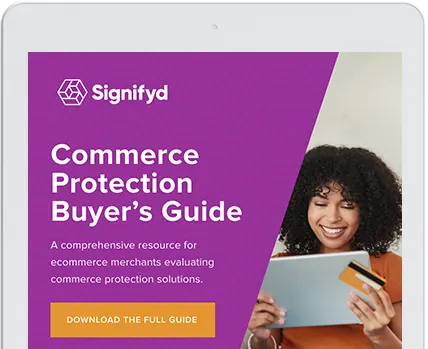There is a new Enemy No. 1 for ecommerce risk teams looking to maximize profit while protecting the business from fraud and abuse: illegitimate INR claims and SNAD claims.
What’s with the bureaucratic-sounding alphabet soup? INR is shorthand for item not received claims and SNAD is an acronym for significantly not as described claims — two phrases that organized fraud rings are becoming increasingly familiar with. Whether you use the initialized shorthand or the full phrases, they both spell growing trouble for retailers.
Mistakes do happen and sometimes customers don’t receive the items they ordered or they find that the product they ordered online doesn’t live up to its description or that it arrives damaged or missing parts. But sometimes — and with growing frequency lately — unscrupulous customers or professional fraud rings make false claims of missing or damaged packages in order to keep an item and receive a refund or a second delivery of an item.
False INR and SNAD claims cost merchants billions of dollars
At one time, merchants practically shrugged off INR and SNAD claims as the cost of doing business. Even the industry term, “friendly fraud,” undersold the damage the practice does. But in recent years, as consumers have become more online savvy and fraud rings have diversified their attacks. What’s now known as “ first-party fraud,” including INR and SNAD claims, has become an expensive and aggravating problem. Identity-specialist firm Socure recently cited multiple sources while concluding that ecommerce first-party fraud and abuse had grown to an $89 billion problem annually in the U.S. alone.
“First-party fraud is picking up,” Sidharth Shah, lead product manager for fraud and payments at online banking platform Novo told Signifyd. “It used to be that you would have bad actors and not bad actors. Now you have bad actors. You have not bad actors, but still doing bad things. And then you have good actors. And so now there’s multiple categories of this because it’s like fraud is now not just about intent, it’s also about opportunity. I do think first-party fraud is going to pick up in a big way.”
Friendly fraud is a growing and big, big problem
Sidharth Shah says that as first-party fraud grows in prominence it also becomes harder to tell good customers from harmful ones. And, the product lead for fraud and payments at Novo says the problem will only get worse in coming years.
The rising popularity of SNAD and INR fraud
When the Merchant Risk Council (MRC) surveyed online retailers for its 2024 Global Ecommerce Payments & Fraud Report, they found that refund and policy abuse and first-party fraud (friendly fraud’s less-friendly new name) were merchants’ two biggest fraud problems. In fact, 63% of the 1,100 merchants that the MRC surveyed said the problem had grown worse in the previous year.
The merchants’ concerns were validated in July when the MRC delivered an email alert to its entire membership of 600+ merchants, solution providers, law enforcement agencies and other organizations warning of “an unprecedented increase” in first-party fraud and abuse.
The warning particularly called out false item not received claims and significantly not as described claims, which it described as “goods not received” and “goods damaged” reasons.
Panelists at Signifyd’s FLOW Summit 2024 underscored how big a problem first-party fraud can be for merchants. Richard Barbieri, director of payments & risk operations, at BetMGM, said his company estimates that 70% to 80% of the disputes they deal with are first-party fraud. The percentage is high partly because gaming platforms hold great potential for buyer’s remorse.
First-party fraud is no small matter for merchants
BetMGM’s Richard Barbieri and Dorian Huynh, of Reebelo, talk about the significant percentage of their fraud and risk challenges that stem from first-party fraud schemes at Signifyd’s FLOW Summit 2024. To see the video of the full panel discussion visit the FLOW Summit on-demand library.
Dorian Huynh, senior fraud manager at electronics marketplace Reebelo said first-party fraud accounted for as much as half of the company’s disputes depending on the season and other factors. The number, he said, includes first-party fraud that results in both fraud and non-fraud chargebacks.
“I think a lot of consumers realize that if they tell their banks, their issuers, ‘I didn’t do this, even though you have communication to prove otherwise, that they’re more likely to get a dispute through — and won — from their perspective,” Huynh said.
How to prevent SNAD and INR fraud
So, if you’re a merchant, how can you best protect yourself from this rising army of consumers ready to file an illegitimate SNAD claim or INR claim? It starts by taking a step back to break down your strategy into distinct areas of exploration.
Like so much in the world of fraud, the answer is complicated. When thinking about avoiding INR and SNAD claims, it’s good to keep in mind the different motivations consumers have for lying about whether a package arrived or a product was damaged or otherwise unsatisfactory.
“Within the chargeback personas of first-party abuse, there are essentially two types of personas. One where people are malicious; they essentially want to defraud a system,” Abhay Antony, a trust and safety director at Thumbtack, told Signifyd. “The other, and the more interesting component of the persona, would be people who had a bad experience with the product, with the platform, had a bad conversation with the customer service agent, or are somehow frustrated with something within the system, and then they’ve filed a dispute as a last resort to get a resolution.”
First-party fraud types: those hell-bent on abuse and frontier-justice seekers
Abhay Antony, Thumbtack’s director of trust and safety and proactive policy, runs down the two main types of first-party fraudsters. One group is out to score products and money from the get-go. The other feels they were treated unfairly and they’ve got a way to get even.
The malicious fraudster, Antony said, is a big challenge. They are determined to get a product and a refund. The second type of first-party fraudster can generally be avoided by building a better customer experience.
What motivates consumers to commit fraud?
1) Frustration motivates consumers to cheat
Fraudster No. 2 will typically file a chargeback because a shipment was delayed or a customer service agent was unhelpful or it was unclear how to request a legitimate refund or send a return or because instructions for operating a product are not clear.
Improving communication channels — for instance, letting a customer know a delivery is delayed and providing an updated delivery date — can help. Better training for customer service agents, so they can answer questions and having reliable and easily accessible support for products of a more technical nature helps, too. Being clear and clearly displaying refund and return policies can curb claims filed by customers seeking frontier justice. Even making sure your website accurately describes and depicts the products you sell can avoid pushing consumers to the brink — or beyond — when it comes to filing a chargeback.
2) They want to get something for nothing
As for the malicious fraudsters — those that Tara Mitchell, Signifyd’s senior director, chargeback & abuse recoveries, describes as “hell-bent on fraud” — merchants must consider them as a very determined adversary. Their goal is to get a product and a refund — or to get a second version of a product. Such chargebacks might even be coming from an organized criminal ring that is in the business of defrauding merchants through INR and SNAD claims. The MRC warned about as much in the summer advisory to its members.
“We suspect that the fraudsters are sharing this information and that the volume we are hearing about is either systemic, organized through various online fraud-as-a-service sites or both,” the MRC advisory said.
How to determine if a SNAD or INR claim is real or fraudulent
The MRC’s advice to merchants was to analyze transactions with an eye toward red flags that would indicate orders destined for a chargeback were coming in. Specifically keep a constant eye on measures that show refund requests or refunds paid are accelerating to levels out of the ordinary. The metrics to look at, the MRC said, include things like:
- Refund rate
- Repeated refund requests
- Refund amount as a percentage of sales, including replacement products
- Refund reason
- Customer lifetime refund rate
- Call center volumes
What to do when you receive a false SNAD or INR claim
Beyond that vigilance, merchants should be prepared to build the case they need to dispute a chargeback with the card networks. That means being familiar with the rules, such as Visa’s credible evidence 3.0 guidelines, which very specifically outline what evidence of first-party fraud a merchant must produce to have a chargeback overturned.
Knowing the requirements, along with diligent record-keeping and detective work will increase your chances of success when it comes to fighting illegitimate chargebacks. The additional steps to think about here are:
- Establish a history of undisputed transactions: This demonstrates that the cardholder in question has satisfactorily purchased from you before.
- Keep track of tracking: Fulfillment information provides evidence that the package was delivered. This evidence sometimes includes a signature from the customer who ordered the package.
- Use customer communication: In some cases, customers will signal that they intend to file a chargeback for reasons that do not justify one.
- Cite your policies: There may be cases in which your policies expressly say refunds will not be granted for the type of scenario the customer is providing as a reason for a refund request.
- Scour social media: There have been cases — and not just a few — where a consumer publishes boastful posts including photos of the product they said they didn’t receive. Yes, really.
A number of experts, including Novo’s Shah, say the best strategy for stemming the friendly fraud tide is a consortium model. A consortium model envisions many merchants sharing data among themselves to build an understanding of the identity and intent behind online transactions.
Reduce fraud by tailoring friction to the level of risk involved
Consortium models have become a realistic option in large part through technological innovation. Large networks of many merchants produce vast amounts of data that machine-learning models can harness to gain insight into the identity and intent behind each online transaction. Going a step further, AI-driven solutions can then produce a response to a return or refund request that adds an appropriate amount of friction to the transaction depending on the risk involved.
For instance, a merchant’s best customers might receive an instant refund, even before returning a product. A high-risk request might require that the customer return the product to receive a store credit once the item has been inspected.
Signifyd is among those that provide a consortium model, which it launched a decade ago. Today Signifyd’s Decision Center is powered by a Commerce Network that has insights into 600 million digital wallets. Those insights mean that Signifyd has seen attributes of 98% of consumers arriving at a merchant’s site conducting transactions elsewhere on its network.
Decision Center allows merchants to calibrate their responses to refund requests depending on the risk that accompanies a given request.
If anything is clear after the events of the past few years — and particularly the last few months — it’s that false INR claims and SNAD claims are not going away. If anything they are becoming an increasingly important revenue stream for professional fraud rings.
That calls for merchants and fraud protection providers to redouble their vigilance and to continue to reach for new solutions that will keep them a step ahead of those looking to harm them.
Looking to get a handle on INR and SNAD? Let’s talk.








